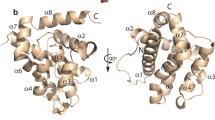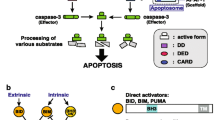Abstract
Key insight into the complexities of apoptosis may be gained from the study of its evolution in lower metazoans. In this study we describe two genes from a cnidarian, Aiptasia pallida, that are homologous to key genes in the apoptotic pathway from vertebrates. The first is a novel ancient caspase, acasp, that displays attributes of both initiator and executioner caspases and includes a caspase recruitment domain (CARD). The second, a Bcl-2 family member, abhp, contains a BH1 and BH2 domain and shares structural characteristics and phylogenetic affinity with a group of antiapoptotic Bcl-2s including A1 and Bcl-2L10. The breadth of occurrence of other invertebrate homologues across the phylogenetic trees of both genes suggests that the complexity of apoptotic pathways is an ancient trait that predates the evolution of vertebrates and higher invertebrates such as nematodes and flies. This paves the way for establishing new lower metazoan model systems for the study of apoptosis.






Similar content being viewed by others
References
Adams JM, Cory S (1998) The Bcl-2 protein family: arbiters of cell survival. Science 281:1322–1326
Ashkenazi A, Dixit VM (1998) Death receptors: signaling and modulation. Science 281:1305–1308
Cepero E, Johnson BW, Boise LH (2001) Cloning and analysis of Bcl-2 family genes. In: Schwartz LM, Ashwell JD (eds) Apoptosis. Academic Press, San Diego, pp 29–47
Choi SS, Park SH, Kim UJ, Shin HS (1997) Bfl-1, a Bcl-2-related gene, is the human homolog of the murine A1, and maps to chromosome 15q24.3. Mamm Genet 8:781–782
Chou JJ, Matsou H, Duan H, Wagner G (1998) Solution structure of the RAIDD CARD and model for CARD/CARD interaction in caspase-2 and caspase-9 recruitment. Cell 94:171–180
Cikala M, Wilm B, Hobmayer E, Böttger A, David CN (1999) Identification of caspases and apoptosis in the simple metazoan Hydra. Curr Biol 9:959–962
Donepudi M, Grütter MG (2002) Structure and zymogen activation of caspases. Biophys Chem 101–102:145–153
Droin NM, Green DR (2004) Role of Bcl-2 family members in immunity and disease. Biochim Biophys Acta 1644:179–188
Dunn SR, Thomason JC, Le Tissier MDA, Bythell JC (2002) Detection of cell death activity during bleaching of the symbiotic sea anemone Aiptasia sp. In: Kasim Moosa MK, Soemodihardjo S, Nontji A, Soegiarto A, Romimohtarto K, Sukarno S (eds) Proceedings of the Ninth International Coral Reef Symposium. Indonesian Institute of Sciences in cooperation with the State Ministry for Environment, Bali, Indonesia, pp 145–155
Dunn SR, Thomason JC, Le Tissier MDA, Bythell JC (2004) Heat stress induces different forms of cell death in sea anemones and their endosymbiotic algae depending on temperature and duration. Cell Death Diff 11:1213–1222
2llis RE, Yuan J, Horvitz HR (1991) Mechanisms and functions of cell death. Annu Rev Cell Biol 7:663–698
Fuentes-Prior P, Salvesen GS (2004) The protein structures that shape caspase-activity, specificity, activation and inhibition. Biochem J 384:201–232
Green DR, Ferguson TA (2001) The role of Fas ligand in immune privilege. Nature Rev Mol Cell Biol 2:917–924
Hall TA (1999) Bioedit: a user-friendly biological sequence alignment editor and analysis program for windows 95/98/NT. Nucleic Acids Symp Ser 41:95–98
Hengartner MO, Bryant JA (2000) Apoptotic cell death: from worms to wombats...but what about the weeds? In: Bryant JA, Hughes SG, Garland JM (eds) Programmed cell death in animals and plants. BIOS Scientific, Oxford, pp 1–9
Hofmann K, Bucher P (1997) The CARD domain: a new apoptotic signaling motif. Trends Biol Sci 22:155–156
Huang Q, Petros AM, Virgin HW, Fesik E, Olejniczak T (2002) Solution structure of a Bcl-2 homolog from Kaposi’s sarcoma virus. Proc Nat Acad Sci USA 99:3428–3433
Huelsenbeck JP (2001) MRBAYES: Bayesian inference of phylogenetic trees. Bioinformatics 17:754–755
Hulsenbeck JP, Rannala B (2004) Frequentist properties of Bayesian posterior probabilities of phylogenetic trees under simple and complex substitution models. Syst Biol 53:904–913
Humke EW, Shriver SK, Starovasnik MA, Fairbrother WJ, Dixit VM (2000) Iceberg; a novel inhibitor of interleukin-1beta generation. Cell 103:99–111
Inohara N, Gourley TS, Carrio R, Muniz M, Merino J, Garcia I, Koseki T, Hu Y, Chen S, Nenez G (1998) Diva, a Bcl-2 homologue that binds directly to Apaf-1 and induces BH3-independent cell death. J Biol Chem 273:32479–32486
Itoh T, Itoh A, Pleasure D (2003) Bcl-2 related protein family gene expression during oligodendroglial differentiation. J Neurochem 85:1500–1512
Jones DT (1999) PSIPRED secondary structure prediction based on position-specific scoring matrices. J Mol Biol 292:195–202
Kenny JJ, Knobloch TJ, Augustus M, Carter KC, Rosen CA, Lang JC (1997) GRS, a novel member of the Bcl-2 gene family, is highly expressed in multiple cancer cell lines and in normal leukocytes. Oncogene 14:997–1001
Ko JK, Lee MJ, Cho SH, Cho JA, Lee BY, Koh JS, Lee SS, Shim YH, Kim CW (2003) Bfl-1, a novel alternative splice variant of Bfl-1, localises in the nucleus via its C-terminus and prevents cell death. Oncogene 22:2457–2465
Kortschak DR, Samuel G, Saint R, Miller DJ (2003) EST analysis of the cnidarian Acropora millepora reveals extensive gene loss and rapid sequence divergence in the model invertebrates. Curr Biol 13:2190–2195
Kozopas KM, Yang T, Buchan HL, Zhou P, Craig RW (1993) MCL1, a gene expressed in programmed myeloid cell differentiation, has sequence similarity to Bcl2. Proc Natl Acad Sci USA 90:3516–3520
Kuo J, Chen M-C, Lin C-H, Fang LS (2004) Comparative gene expression in the symbiotic and aposymbiotic Aiptasia pulchella by expressed sequence tag analysis. Biochem Biophys Res Commun 318:176–186
Kusserow A, Pang K, Sturm C, Hrouda M, Lentfer J, Schmidt HA, Technau Y, Haeseler Av, Hobmayer B, Martindale MQ, Holstein TW (2005) Unexpected complexity of the Wnt gene family in a sea anemone. Nature 433:156–160
Kuznetsov SG, Anton-Erxleben F, Bosch TCG (2002) Epithelial interactions in Hydra: apoptosis in interspecies grafts is induced by detachment from the extracellular matrix. J Exp Biol 205:3809–3817
Lamkanfi M, Declercq W, Kalai M, Saelens X, Vandenabeele P (2002) Alice in caspase land. A phylogenetic analysis of caspases from worm to man. Cell Death Differ 9:358–361
Leo CP, Hsu SY, Chun SY, Bae HW, Hsueh AJ (1999) Characterisation of the anti-apoptotic Bcl-2 family member myeloid cell leukemia-1 (Mcl-1) and the stimulation of its message by gonadotropins in the rat ovary. Endocrinology 140:5469–5477
Li X, Darzynkiewicz Z (2000) Cleavage of Poly(ADP-ribose) polymerase measured in situ in individual cells: relationship to DNA fragmentation and cell cycle position during apoptosis. Exp Cell Res 255:125–132
Lin EY, Orlofsky A, Berger MS, Prystowsky MB (1993) Characterization of A1, a novel hemopoietic-specific early response gene with sequence similarity to bcl-2. J Immunology 151:1979–1988
MacDonald G, Shi LF, Velde CV, Lieberman J, Greenberg AH (1999) Mitochondria-dependent and independent regulation of granzyme B-induced apoptosis. J Exp Med 189:131–143
McGuffin LJ, Jones DT (2003) Improvement of the GenTHREADER method for genomic fold recognition for genomic sequences. Bioinformatics 19:874–881
McGuffin LJ, Bryson K, Jones DT (2000) The PSIPRED protein structure prediction server. Bioinformatics 16:404–405
Mire P, Venable S (1999) Programmed cell death during longitudinal fission in a sea anemone. Invert Biol 118:319–331
Muchmore SW, Sattler M, Liang H, Meadows RP, Harlan JE, Yoon HS, Nettlesheim D, Chang BS, Thompson CB, Wong SL, Ng SL, Fesik SW (1996) X-Ray and NMR structure of human Bcl-xL, an inhibitor of programmed cell death. Nature 381:335–341
Nicholson DW (1999) Caspase structure, proteolytic substrates, anf function during apoptotic cell death. Cell Death Differ 6:1028–1042
Nicholson DW, Thornberry NA (1997) Caspases: killer proteases. Trends Biol Sci 22:299–306
Okamoto Y, Anan H, Nakai E, Morihira K, Kurihara H, Sakashita H, Terai Y, Takeuchi M, Shibanuma T, Isomura Y (1999) Peptide based interleukin-1beta converting enzyme (ICE) inhibitors: synthesis, structure, activity relationship and crystallographic study of the inhibitor complex. Chem Pharm Bull 47:11–21
Oltvai ZN, Milliman CL, Korsmeyer SJ (1993) Bcl-2 heterodmerizes in-vivo with a conserved homolog, Bax that accelerates programmed cell death. Cell 74:609–619
Piana S, Sulpizi M, Rothlisberger U (2003) Structure-based thermodynamic analysis of caspases reveals key residues for dimerization and activity. Biochemistry 42:8720–8728
Qin H, Srinivasula MS, Wu G, Fernandes-Alnemri T, Alnemri ES, Shi Y (1999) Structural basis of pro-caspase-9 recruitment by apoptotic protease-activating factor 1. Nature 399:549–557
Reed JC (1998) Bcl-2 family proteins. Oncogene 17:3225–3236
Rotonda J, Nicholson DW, Fazil KM, Gallant M, Labelle M, Peterson EP, Rasper DM, Ruel R, Vaillancourt JP, Thornberry NA, Becker JW (1996) The three dimensional structure of apopain/CPP32, a key mediator of apoptosis. Nat Struct Biol 3:619–625
Sander C, Schneider R (1991) Database of homology-derived protein structures and the structural meaning of sequence alignment. Proteins Struct Funct Genet 9:56–68
Schweizer A, Briand C, Grutter MG (2003) Crystal structure of caspase-2, apical initiator of the intrinsic apoptotic pathway. J Biol Chem 278:42441–42447
Song Q, Kuang Y, Dixit VM, Vincenz C (1999) Boo, a novel negative regulator of cell death interacts with Apaf-1. EMBO J 18:167–178
Srinivasula MS, Saleh A, Ahmad M, Fernandes-Alnemri T, Alnemri ES (2001) Isolation and assay of caspases. In: Schwartz LM, Ashwell JD (eds) Apoptosis. Academic Press, San Diego
Suryaprasad AG, Prindiville T (2003) The biology of the TNF blockade. Autoimmun Rev 2:346–357
Suzuki M, Youle RJ, Tjandra N (2000) Structure of Bax: coregulation of dimer formation and intracellular localization. Cell 103:645–654
Swofford D (2004) PAUP: phylogenetic analysis using parsimony. Sinauer Associates, Sunderland, MA
Thompson JD, Gibson TJ, Plewniak F, Jeanmougin F, Higgins DG (1997) The ClustalX windows interface: flexible strategies for multiple sequence alignment aided by quality analysis tools. Nucleic Acids Res 24:4876–4882
Uren AG, O’Rourke K, Aravind L, Pisabarro MT, Seshagirl S, Koonin EV, Dixit VM (2000) Identification of paracaspases and metacaspases: two ancient families of caspase-like proteins, one of which plays a key role in MALT Lymphoma. Mol Cell 6:961–967
Vaughn DE, Rodriguez J, Lazebnik Y, Joshua-Tor L (1999) Crystal structure of the Apaf-1 caspase recruitment domain: an alpha-helical greek key fold for apoptosis signaling. J Mol Biol 293:439–447
Wiens M, Krasko A, Müller CI, Müller WEG (2000) Molecular evolution f apoptotic pathways: Cloning of key domains from sponges (Bcl-2 homology domains and death domains) and their phylogenetic relationships. J Mol Evol 50:520–531
Wiens M, Krasko A, Perovic S, Müller WEG (2003) Caspase-mediated apoptosis in sponges: cloning and function of the phylogenetic oldest apoptotic proteases from Metazoa. Biochim Biophys Acta 1593:179–189
Wilkins MR, Lindskog I, Gasteiger E, Bairoch A, Sanchez J-C, Hochstrasser DF, Appel RD (1997) Detailed peptide characterisation using PEPTIDEMASS—a World-Wide Web accessible tool. Electrophoresis 18:403–408
Woo EJ, Kim YG, Kim MS, Han WD, Shin S, Robinson H, Park SY, Oh BH (2004) Structural mechanism for inactivation and activation of CAD/DFF40 in the apoptotic pathway. Mol Cell 14:531–539
Wyllie AH, Kerr JFK, Currie AR (1980) Cell death: the significance of apoptosis. Int Rev Cytol 68:251–306
Yan N, Gu L, Kodel D, Chai J, Li W, Han A, Chen L, Xue D, Shi Y (2004) Structural, biochemical, and functional analysis of Ced-9 recognition by the proapoptotic proteins Egl-1 and Ced-4. Mol Cell 15:999–1006
Yuan J, Shaham S, Ledoux S, Ellis HM, Horvitz HR (1993) The C. elegans cell death gene ced-3 encodes a protein similar to mammalian interlukin-1b-converting enzyme. Cell 75:641–652
Zhang H, Holzgreve W, De Geyter C (2001) Bcl2-L-10, a novel anti-apoptotic member of the Bcl-2 family, blocks apoptosis in the mitochondrial death pathway but not in the death receptor pathway. Hum Mol Genet 10:2329–2339
Zong WX, Edelstein LC, Chen C, Bash J, Gelinas C (1999) The prosurvival Bcl-2 homolog Bfl-1/A1 is a direct transcriptional target of NF-kappa B that blocks TNFalpha induced apoptosis. Genes Dev 13:382–387
Acknowledgments
We gratefully thank members of the Weis lab for their comments on the manuscript. This work was supported by a grant from the National Science Foundation (02372230-MCB) to V.W. and D.G.
Author information
Authors and Affiliations
Corresponding author
Additional information
[Reviewing Editor: Dr. Stuart Newfeld]
Electronic Supplementary Material
Rights and permissions
About this article
Cite this article
Dunn, S.R., Phillips, W.S., Spatafora, J.W. et al. Highly Conserved Caspase and Bcl-2 Homologues from the Sea Anemone Aiptasia pallida: Lower Metazoans as Models for the Study of Apoptosis Evolution. J Mol Evol 63, 95–107 (2006). https://doi.org/10.1007/s00239-005-0236-7
Received:
Accepted:
Published:
Issue Date:
DOI: https://doi.org/10.1007/s00239-005-0236-7




